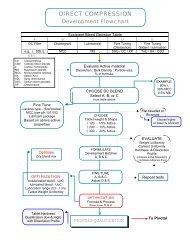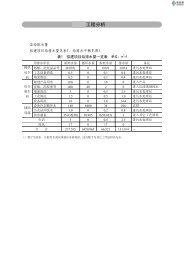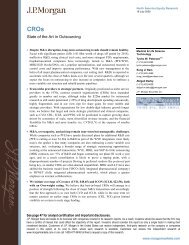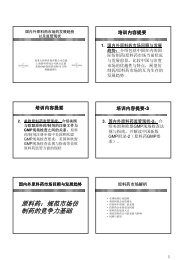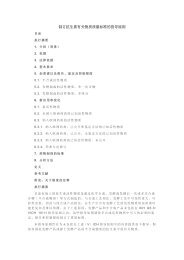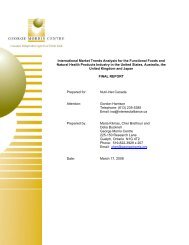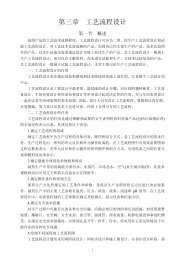Residual Solvents for Drug Substance
Residual Solvents for Drug Substance
Residual Solvents for Drug Substance
Create successful ePaper yourself
Turn your PDF publications into a flip-book with our unique Google optimized e-Paper software.
ANALYTICAL RESEARCH AND<br />
DEVELOPMENT<br />
FOR GENERIC DRUG<br />
仿制药分析研发<br />
Anna Shen Ph.D.<br />
Anbison Analytical Research and development Lab<br />
2009-03-11<br />
ANBISON LAB. 安必生
In<strong>for</strong>mation search and DMF evaluation:<br />
(Literature, Internet-online, Merck index, CPS/PDR,<br />
USP/EP/JP, analytical profiles, patents, etc.)<br />
Physicochemical properties (chemical structure, isomers,<br />
chirality, solubility, stability, pKa, hygroscopicity, mp,<br />
partition coefficient)<br />
List all polymorphic <strong>for</strong>ms reported in literature (which<br />
one is the most stable <strong>for</strong>m)<br />
List all possible impurities based on API synthetic routes<br />
List all organic solvents used in API synthetic process<br />
Predict potential degradants based on the chemical<br />
structure<br />
ANBISON LAB. 安必生
Set-up API Specification:<br />
ICH Q6A– SPECIFICATIONS: TEST PROCEDURES AND<br />
ACCEPTANCE CRITERIA FOR NEW DRUG<br />
SUBSTANCES AND NEW DRUG PRODUCTS:<br />
CHEMICAL SUBSTANCES<br />
A List of Tests<br />
Reference to Analytical Procedures<br />
Appropriate Acceptance Criteria<br />
ANBISON LAB. 安必生
API Specification:<br />
Description (solid/liquid, color)<br />
Identification (IR, UV, Chloride, Sulfate, etc.)<br />
USP General Method<br />
Note: NMR, MS, etc. <strong>for</strong> primary identification standard<br />
Physicochemical properties (mp, pH, RI, acidity/alkalinity,<br />
optical rotation, etc.)<br />
USP General Method<br />
Water content/L.O.D.<br />
USP General Method<br />
Inorganic impurities (Residue on Ignition, Heavy Metals)<br />
USP General Method<br />
ANBISON LAB. 安必生
API Specification:<br />
Assay<br />
In-house method to be developed by HPLC, titration, etc.<br />
Organic impurities/degradants<br />
In-house method to be developed by HPLC<br />
<strong>Residual</strong> solvents<br />
In-house method to be developed by GC<br />
Particle size<br />
USP General method <strong>for</strong> sieve analysis<br />
In-house method to be developed by Laser Diffraction<br />
Polymorphic <strong>for</strong>ms<br />
In-house method to be developed by IR, DSC or X-Ray<br />
ANBISON LAB. 安必生
API Specification:<br />
Tests Acceptance Criteria<br />
Analytical<br />
Procedure<br />
Appearance (表观) White or almost white powder Visual<br />
Identification (鉴别)<br />
A: IR (红外)<br />
B: HPLC-RT<br />
(高效液相保留时间)<br />
C: Chloride (氯离子)<br />
Acidity or alkalinity<br />
(酸度或碱度)<br />
Heavy metals<br />
(重金属)<br />
Loss on drying<br />
(干燥失重)<br />
Residue on ignition<br />
(灼烧残渣)<br />
A. The infrared absorption spectrum must be concordant with the IR spectrum obtained<br />
from Venlafaxine HCl standard. If the spectra obtained in the solid state show<br />
differences, dissolve the substance to be examined and the reference standard<br />
separately in 2-propanol, evaporate to dryness and record new spectra using the<br />
residues.<br />
B. The retention time of the major peak in the chromatogram of the assay preparation<br />
corresponds to that in the chromatogram of the standard preparation<br />
C. It gives positive reaction <strong>for</strong> chlorides<br />
Dissolve 0.20 g in carbon dioxide-free water and dilute to 10 ml with the same<br />
solvent. Add 0.05 ml of methyl red solution and 0.1 ml of 0.01 M hydrochloric acid.<br />
The solution is pink. NMT 0.2 ml of 0.01 M sodium hydroxide is required to change<br />
the color of the indicator to yellow.<br />
NMT 20 ppm (10ppm in Carelife COA)<br />
Dissolve 1.0 g in 20 ml of water. 12 ml of the solution complies with the test A<br />
Prepare the reference solution using lead standard solution (1 ppm Pb).<br />
Dry it in vacuo at 80 o C <strong>for</strong> 3 hours:<br />
It loses NMT 0.5% of its weight<br />
NMT 0.1%<br />
USP<br />
In-house Method<br />
ABS_T002A_1.0<br />
USP< 191><br />
USP <br />
USP<br />
Method?<br />
USP<br />
USP<br />
Assay (含量) by HPLC 99.0% to 101.0% of C 17 H 28 ClNO 2 on the dried basis In-house Method<br />
<strong>Residual</strong> solvents<br />
(残留溶剂)<br />
by GC<br />
Related compounds<br />
(相关物质)<br />
by HPLC<br />
Particle size (粒径)<br />
Polymorphism (晶形)<br />
Ether: NMT 5000 ppm<br />
Tetrahydrofuran: NMT 720 ppm<br />
Methanol: NMT 3000 ppm<br />
2-Propanol: NMT 5000 ppm<br />
Ethyl acetate: NMT 5000 ppm (not in Carelife COA)<br />
Toluene: NMT 890 ppm<br />
Specified impurities:<br />
Ven-imp-1*: NMT 0.15%<br />
EP-impurity C**: NMT 0.15%<br />
EP-impurity F***: NMT 0.15%<br />
Each unknown impurity: NMT 0.10%<br />
Total impurities: NMT 0.5%<br />
In-house Method<br />
ABS_T002A_1.0<br />
In-house Method<br />
ABS_T002A_1.0<br />
Test Results<br />
Lot#<br />
ANBISON LAB. 安必生<br />
In-house Method<br />
In-house Method
Acceptance Criteria<br />
USP monograph or other compendia monograph<br />
(EP, BP, JP etc.)<br />
DMF holder’s specification (DMF)<br />
ICH guidelines:<br />
Impurities in <strong>Drug</strong> <strong>Substance</strong>: ICH Q3A(R2)<br />
Impurities in <strong>Drug</strong> Products: ICH Q3B(R2)<br />
Impurities: <strong>for</strong> <strong>Residual</strong> <strong>Solvents</strong>: ICH Q3C(R3)<br />
Use MDD to calculate the ICH Thresholds:<br />
Reporting Threshold (RT)<br />
Identification Threshold (IT)<br />
Qualification Threshold (QT)<br />
ANBISON LAB. 安必生
Acceptance Criteria:<br />
Maximum<br />
Daily Dose 1<br />
Reporting<br />
Threshold 2,3<br />
Identification<br />
Threshold<br />
≤ 2g/day 0.05% 0.10% or<br />
1.0 mg per day intake<br />
(whichever is lower)<br />
> 2g/day 0.03% 0.05% 0.05%<br />
1 The amount of drug substance administered per day<br />
Qualification<br />
Threshold 3<br />
0.15% or<br />
1.0 mg per day intake<br />
(whichever is lower)<br />
2 Higher reporting thresholds should be scientifically justified<br />
3 Lower thresholds can be appropriate if the impurity is unusually toxic<br />
ANBISON LAB. 安必生
Acceptance Criteria:<br />
Justification <strong>for</strong> the acceptance criterion <strong>for</strong> each test<br />
should be provided.<br />
Justify limits above Qualification Threshold (QT) with:<br />
USP monograph<br />
Literature or other compendial monographs (EP, BP, JP, etc.)<br />
Metabolite of the drug substance<br />
Compare RLD product<br />
Pharm/Toxicity Study<br />
ANBISON LAB. 安必生
Analytical Methods Need to be Developed <strong>for</strong> API:<br />
Assay <strong>for</strong> <strong>Drug</strong> <strong>Substance</strong><br />
Related Compounds <strong>for</strong> <strong>Drug</strong> <strong>Substance</strong><br />
<strong>Residual</strong> <strong>Solvents</strong> <strong>for</strong> <strong>Drug</strong> <strong>Substance</strong><br />
Particle size <strong>for</strong> <strong>Drug</strong> <strong>Substance</strong><br />
Polymorphic <strong>for</strong>ms <strong>for</strong> <strong>Drug</strong> <strong>Substance</strong><br />
ANBISON LAB. 安必生
All Methods Need to be Validated <strong>for</strong> API:<br />
Assay <strong>for</strong> <strong>Drug</strong> <strong>Substance</strong><br />
Related Compounds <strong>for</strong> <strong>Drug</strong> <strong>Substance</strong><br />
<strong>Residual</strong> <strong>Solvents</strong> <strong>for</strong> <strong>Drug</strong> <strong>Substance</strong><br />
Particle size <strong>for</strong> <strong>Drug</strong> <strong>Substance</strong><br />
Polymorphic <strong>for</strong>ms <strong>for</strong> <strong>Drug</strong> <strong>Substance</strong><br />
ANBISON LAB. 安必生
Method Validation Reports Need to be Summited:<br />
Assay <strong>for</strong> <strong>Drug</strong> <strong>Substance</strong><br />
Related Compounds <strong>for</strong> <strong>Drug</strong> <strong>Substance</strong><br />
<strong>Residual</strong> <strong>Solvents</strong> <strong>for</strong> <strong>Drug</strong> <strong>Substance</strong><br />
Particle size <strong>for</strong> <strong>Drug</strong> <strong>Substance</strong><br />
Polymorphic <strong>for</strong>ms <strong>for</strong> <strong>Drug</strong> <strong>Substance</strong><br />
ANBISON LAB. 安必生
Compendial Method Validation/Verification:<br />
For Methods adapted from USP:<br />
USP assay method is specific (e.g., main peak can be<br />
separated from all process impurities arising from your<br />
manufacturing process and from degradation products);<br />
USP related substance method is specific (e.g., all your<br />
process impurities and degradants can be separated each<br />
other and also separated from main peak).<br />
For method adapted from DMF/BP/EP:<br />
Reproduce the method validations/verifications<br />
Full validation reports or<br />
Full validation reports from DMF holder and method<br />
transfer report<br />
ANBISON LAB. 安必生
Reference Standard:<br />
If a USP RS is available:<br />
Using USP RS as primary RS<br />
Provide USP RS Lot number<br />
Qualification <strong>for</strong> an “In-house working standard”:<br />
Source and Lot#<br />
Certificate of analysis (including potency<br />
assessment against USP RS and USP RS Lot<br />
number )<br />
ANBISON LAB. 安必生
Reference Standard:<br />
If a USP RS is not available:<br />
Identify Primary RS source and Lot number<br />
All related characterization in<strong>for</strong>mation <strong>for</strong> the drug<br />
substance (IR, Mass, 1 H and 13 C NMR spectroscopy,<br />
elemental analysis etc.) should be provided:<br />
Full test results including purity test <strong>for</strong> this primary RS<br />
lot should be provided.<br />
Qualification <strong>for</strong> an “In-house working standard”:<br />
Source and Lot#<br />
Certificate of analysis (including potency test against<br />
primary RS)<br />
ANBISON LAB. 安必生
Impurities in <strong>Drug</strong> <strong>Substance</strong><br />
Summarize all potential and actual impurities<br />
arising from the synthesis/degradation<br />
Identify impurities by names, impurity ID, chemical<br />
structures, or RRT/HPLC<br />
Specify impurities as process impurities and/or<br />
degradant (impurities origin)<br />
ANBISON LAB. 安必生
Solubility Determination and BCS Classification:<br />
The aqueous solubility as a function of pH at 37º C<br />
0.1 N HCl<br />
0.01 N HCl<br />
Solvent Media pH of<br />
Media<br />
Final<br />
pH*<br />
pH Solubility**<br />
1 1.0<br />
(mg/ml)<br />
47.2<br />
0.15 M acetate buffer 4 3.7 56.8<br />
0.15 M phosphate buffer<br />
6 5.8 60.8<br />
0.15 M phosphate buffer<br />
2 1.7 49.2<br />
8 7.8 56.0<br />
* Refers to the pH of aqueous media following addition of <strong>Drug</strong> <strong>Substance</strong><br />
** Solubility measures were carried out on polymorphic Form I, the <strong>for</strong>m used in the DP.<br />
Note: The relative solubility (at one pH) should be provided <strong>for</strong> any other more stable <strong>for</strong>ms.<br />
Calculated dose solubility volume: 32 mg (highest strength)÷(47.2 mg/ml) = 0.68 ml.<br />
Since the dose solubility volume is less than 250 ml, based on BCS System: the drug<br />
substance is high solubility<br />
ANBISON LAB. 安必生
In<strong>for</strong>mation to be Referenced to the DMF:<br />
<strong>Drug</strong> substance structure elucidation<br />
<strong>Drug</strong> substance manufacturing process and<br />
controls<br />
Container/closure system used <strong>for</strong> packaging<br />
and storage of the drug substance<br />
<strong>Drug</strong> substance stability<br />
ANBISON LAB. 安必生
In<strong>for</strong>mation Required from ANDA Holder <strong>for</strong> API:<br />
Physicochemical properties (pKa, Polymorphism, solubility,<br />
hygroscopicity, mp, Log P)<br />
Manufacture and per<strong>for</strong>mance-NEW<br />
Adequate drug substance specification<br />
Test methods (Full details of test procedure,<br />
chromatograms)<br />
Impurity profile in drug substance (process impurities and<br />
degradants)<br />
Limits <strong>for</strong> impurities/residual solvents<br />
Method validation/verification reports <strong>for</strong> all methods<br />
Reference standard<br />
Stress study/Chromatograms<br />
ANBISON LAB. 安必生
Set-up DP Specification:<br />
ICH Q6A– SPECIFICATIONS: TEST PROCEDURES AND<br />
ACCEPTANCE CRITERIA FOR NEW DRUG<br />
SUBSTANCES AND NEW DRUG PRODUCTS:<br />
CHEMICAL SUBSTANCES<br />
A List of Tests<br />
Reference to Analytical Procedures<br />
Appropriate Acceptance Criteria<br />
ANBISON LAB. 安必生
<strong>Drug</strong> Product Specification:<br />
Appearance (外观)<br />
Visual<br />
Identification (鉴别)<br />
A: IR (红外)<br />
USP General method, but the sample preparation<br />
procedure needs to be developed<br />
B: HPLC-RT (高效液相保留时间)<br />
Same as Assay method<br />
Dissolution (溶出度)<br />
In-house method to be developed by UV or HPLC<br />
Content Uni<strong>for</strong>mity(均匀度)<br />
In-house method to be developed by HPLC<br />
Assay (含量)<br />
In-house method to be developed by HPLC<br />
Degradation Products (降解产物)<br />
In-house method to be developed by HPLC<br />
<strong>Residual</strong> solvents (残留溶剂) if used in <strong>for</strong>mulation<br />
In-house method to be developed by GC<br />
ANBISON LAB. 安必生
<strong>Drug</strong> Product Specification:<br />
Tests Acceptance Criteria<br />
Analytical<br />
Procedure<br />
Appearance (外观) Visual<br />
Identification (鉴别)<br />
A: IR (红外)<br />
B: HPLC-RT<br />
(高效液相保留时间)<br />
Dissolution<br />
(溶出度)<br />
Content Uni<strong>for</strong>mity<br />
(均匀度)<br />
A: The IR spectrum matches that of Venlafaxine<br />
HCl RS between 4000-650 cm-1 .<br />
B: The retention time of the major peak in the<br />
chromatogram of the assay preparation<br />
corresponds to that of the standard preparation as<br />
obtained in the assay.<br />
USP<br />
Not less than 80% (Q) of the labeled claim is dissolved<br />
in 30 minutes<br />
USP<br />
In-house Method<br />
ABS_T002A_1.0<br />
In-house Method<br />
ABS_T002D_1.0<br />
Meet requirements of USP In-house Method<br />
ABS_T002C_1.0<br />
Assay (含量) 95.0% to 105.0% of the labeled claim of C 17 H 27 NO 2 In-house Method<br />
Degradation Products<br />
(降解产物)<br />
<strong>Residual</strong> solvents<br />
(残留溶剂)<br />
Specified impurities:<br />
EP-impurity F*: NMT 0.2%<br />
Each unspecified impurity: NMT 0.20%<br />
Total impurities: NMT 0.5%<br />
Method<br />
ABS_T002I_1.0<br />
Test Results<br />
Lot #<br />
Based on the Statements from API/Excipients and the calculation as per USP Option 2,<br />
the product meets the USP residual solvent limits criteria. No testing is needed.<br />
ANBISON LAB. 安必生
Acceptance Criteria<br />
USP monograph or other compendia monograph<br />
(EP, BP, JP etc.)<br />
DMF holder’s specification (DMF)<br />
ICH guidelines:<br />
Impurities in <strong>Drug</strong> <strong>Substance</strong>: ICH Q3A(R2)<br />
Impurities in <strong>Drug</strong> Products: ICH Q3B(R2)<br />
Impurities: <strong>for</strong> <strong>Residual</strong> <strong>Solvents</strong>: ICH Q3C(R3)<br />
Use MDD to calculate the ICH Thresholds:<br />
Reporting Threshold (RT)<br />
Identification Threshold (IT)<br />
Qualification Threshold (QT)<br />
ANBISON LAB. 安必生
Analytical Methods Need to be Developed <strong>for</strong> DP:<br />
Assay/CU <strong>for</strong> <strong>Drug</strong> Product<br />
Degradation Products <strong>for</strong> <strong>Drug</strong> Product<br />
Dissolution <strong>for</strong> <strong>Drug</strong> Product<br />
<strong>Residual</strong> <strong>Solvents</strong> <strong>for</strong> <strong>Drug</strong> Product<br />
ANBISON LAB. 安必生
All Methods Need to be Validated <strong>for</strong> DP:<br />
Assay/CU <strong>for</strong> <strong>Drug</strong> Product<br />
Degradation Products <strong>for</strong> <strong>Drug</strong> Product<br />
Dissolution <strong>for</strong> <strong>Drug</strong> Product<br />
<strong>Residual</strong> <strong>Solvents</strong> <strong>for</strong> <strong>Drug</strong> Product<br />
ANBISON LAB. 安必生
Method Validation Reports Need to be Summited:<br />
Assay/CU <strong>for</strong> <strong>Drug</strong> Product<br />
Degradation Products <strong>for</strong> <strong>Drug</strong> Product<br />
Dissolution <strong>for</strong> <strong>Drug</strong> Product<br />
<strong>Residual</strong> <strong>Solvents</strong> <strong>for</strong> <strong>Drug</strong> Product<br />
ANBISON LAB. 安必生



